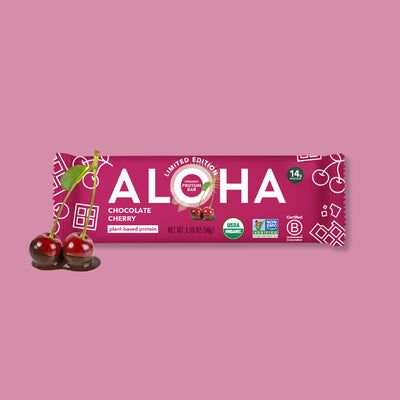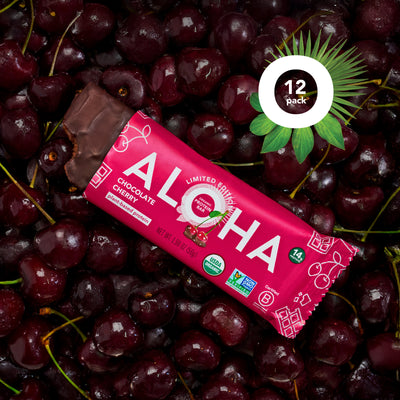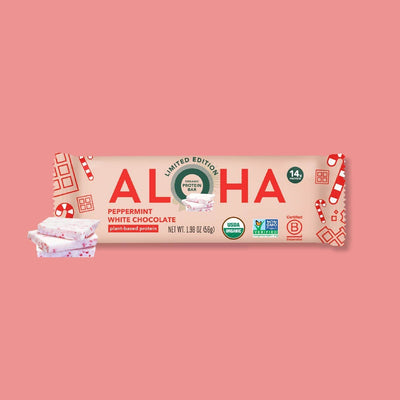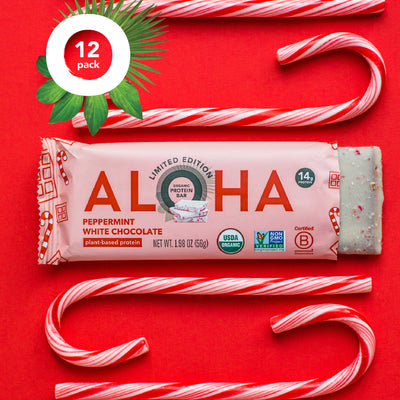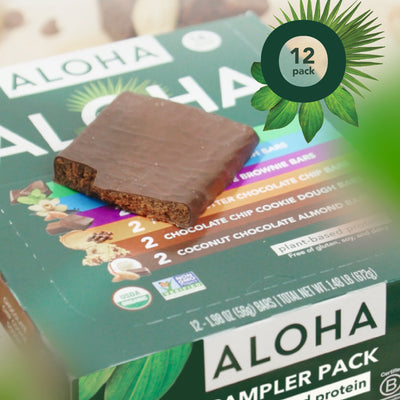Key Takeaways:
- Daily Needs Matter: Eating protein consistently throughout the day supports energy, fullness, and better nutrient absorption.
- Plant-Based Wins: You don’t need meat to meet your goals. Plant-based sources like legumes, seeds, and ALOHA products make it easy.
- Small Swaps Work: Boosting protein is about small, steady upgrades to your current meals rather than completely changing your diet.
Getting enough protein each day helps you feel full, energized, and ready for whatever’s on your plate. But if you’re not tracking macros or counting grams, it’s easy to miss the mark without even realizing it. The good news is that you don’t need to completely change your diet or rely on animal products to increase your protein intake. With a few simple shifts like smart snacks and upgraded meals, you can add more protein to your routine in a way that feels natural and sustainable.
At ALOHA, we’ve been keeping plant-based protein simple for over a decade. Our bars and shakes are made with real, recognizable ingredients, and we’re proud to be a Certified B Corporation. We care deeply about what goes into our products and how they make you feel. That’s why everything we make is designed to support your goals without getting in the way of real life.
In this piece, we’ll be talking about how to increase protein intake in everyday ways that actually stick. Simple tips, practical swaps, and ideas you can start using right away.
Why Getting Enough Protein Matters
Protein plays a big role in how your body functions each day. It supports your muscles, bones, skin, and hair while helping repair tissues and create enzymes that keep your body running smoothly. It also supports a healthy immune system and contributes to overall wellness, making it one of the most important nutrients you can focus on.
Getting enough protein helps with energy and focus too. Because it digests more slowly than carbohydrates, it keeps you feeling full for longer periods of time. That steady energy means fewer mid-afternoon crashes and less snacking on quick fixes that don’t really satisfy.
Making protein a steady part of your meals can help you feel balanced and strong. Whether your goal is building strength, improving recovery, or simply feeling more satisfied after eating, protein can help you get there. Small, consistent steps can make a big difference in how you feel throughout the day.
How Much Protein Do You Actually Need?
The amount of protein you need depends on a few things, like your age, activity level, and personal goals. For most people, a good general target is around 0.8 to 1 gram of protein per kilogram of body weight. If you’re active, trying to build muscle, or in a period of recovery, you might benefit from getting a bit more.
That said, you don’t have to obsess over numbers. Instead of tracking every gram, focus on including a source of protein in each meal and snack. That simple shift can help you naturally hit your needs without turning eating into a math equation.
For athletes or people following a plant-based diet, dialing in your intake might take a little extra intention. We break it down more in our guide to protein intake for athletes and how to get protein on a vegan diet, if you want to go deeper.
Easy Ways to Add More Protein to Your Day
Adding more protein doesn’t require a complete diet overhaul. Small, consistent changes can make a big impact. You can start by including nut butter in your oatmeal, blending a scoop of plant-based protein into your smoothie, or topping your toast with hummus instead of jam.
Look for ways to upgrade meals you already enjoy. Stir lentils into soups, sprinkle hemp seeds on salads, or swap regular pasta for a higher-protein version. Even choosing Greek yogurt instead of traditional yogurt adds extra protein without changing much about the meal itself.
Convenience helps too. Having simple, high-protein options ready can make it easier to stay on track. ALOHA protein bars are a great example. They’re plant-based, portable, and satisfying enough to keep you going between meals or after a workout.
Snack Smarter with High-Protein Options
Snacks are one of the easiest places to sneak in more protein. Instead of reaching for chips or crackers, try something with a bit more staying power. A handful of roasted chickpeas, a protein bar, or a hard-boiled egg can help you stay full between meals and avoid energy dips.
It also helps to think ahead. Stock your pantry or desk with go-to options that don’t require prep. ALOHA protein bars are an easy choice here. They’re plant-based, made with real ingredients, and come in flavors that actually taste good. Keeping a few on hand makes it easier to make a solid choice when you're short on time.
Snacks don’t have to be complicated or boring. Pair apple slices with peanut butter, mix nuts with dried fruit, or grab a protein shake on the way out the door. The goal is to find a mix of protein and satisfaction so your snack feels like it’s doing something good for you.
Best Protein Sources for Plant-Based Eaters
Getting enough protein on a plant-based diet is more accessible than ever. With a variety of whole foods and convenient products available, building a high-protein plate doesn't have to be difficult. Whether you're fully vegan or just trying to eat more plants, there are plenty of ways to meet your protein needs without sacrificing flavor or satisfaction. If you’re looking for more detailed guidance, we’ve broken it down further in our guide to getting protein on a vegan diet.
Whole Food Staples
Some of the best plant-based proteins are already kitchen staples. Lentils, chickpeas, black beans, tofu, tempeh, and quinoa are all strong sources of protein and also bring fiber, iron, and other nutrients to the table. Nuts, seeds, and whole grains also provide protein, especially when used as toppings or mixed into meals you already love.
Combining for Complete Protein
Most plant-based foods don’t contain all nine essential amino acids in one go, but you can easily create complete proteins by combining ingredients. Classic pairs like rice and beans, or hummus with whole grain pita, are naturally complementary. You don’t need to pair them at every meal, but eating a variety throughout the day helps cover your bases.
Convenient Go-To Options
When you're short on time or between meals, having reliable options on hand makes a big difference. ALOHA protein bars and shakes are made with plant-based protein and real ingredients, making them a simple way to stay fueled on busy days. Other ideas include roasted edamame, trail mix with seeds, or a quick smoothie with protein powder and fruit.
Tips for Boosting Protein at Every Meal
One of the easiest ways to get more protein is to spread it out across your day. Instead of loading up at dinner or relying only on snacks, you can make each meal work a little harder for you. With a few small changes at breakfast, lunch, and dinner, it’s possible to meet your protein needs without adding more stress to your routine.
Breakfast Upgrades
Mornings can be busy, but they’re also a great time to set the tone with protein. Adding chia seeds or nut butter to overnight oats, blending a protein smoothie, or grabbing a plant-based protein bar are quick wins. Even swapping regular toast for sprouted grain bread with almond butter can make a difference. These small upgrades help you feel full longer and avoid that mid-morning crash.
Lunchtime Boosts
Lunch is a great opportunity to mix in more plant-based protein. Salads with lentils, grain bowls with tofu, or wraps filled with hummus and veggies can all pack a protein punch. Try adding seeds, beans, or tempeh to meals you already enjoy. The goal is to make your lunch more satisfying without having to cook a separate protein dish.
Dinner Done Right
Dinner doesn’t need to be complicated to be protein-rich. Think of it as rounding out your day with intention. High-protein pasta, stir-fries with edamame or chickpeas, or roasted vegetables with a tahini drizzle can all bring in extra nutrients. Aim for a balance of protein, fiber, and flavor to help you wind down feeling nourished and satisfied.
Don’t Forget Post-Workout Protein
After a workout, your body is in recovery mode. That’s when protein really comes in handy. It helps repair muscle tissue, supports recovery, and can reduce soreness so you feel ready for your next session. Even a short walk or light training session can benefit from a little post-exercise refueling.
The key is to eat something with protein within about an hour of finishing your workout. It doesn’t need to be fancy. A smoothie with plant-based protein, a banana with peanut butter, or an ALOHA bar can all do the trick. The goal is to give your body what it needs to bounce back strong.
Want more detail based on your training level? Our guide on protein intake for athletes dives deeper into how much protein active people might need and how to get it from plant-based sources.
Final Thoughts
Adding more protein to your routine doesn’t have to be complicated. With a few thoughtful choices throughout the day, it becomes part of how you naturally eat. Start small, stay consistent, and build on what already works for you.
The goal isn’t perfection. It’s about feeling more energized, satisfied, and supported by the food you eat. Whether you're fueling workouts, managing cravings, or just trying to stay balanced, protein can play a big role.
And if you're looking for simple, plant-based options that taste good and travel well, ALOHA’s got you covered. From protein bars to shakes, we keep it real so you can keep going.
Read also:
- Ultimate Checklist: Choosing the Best Healthy Protein Bars
- Clean Protein Powder 101: Your Top Questions Answered
- Vegan Proteins 101: Your Top Questions Answered
Frequently Asked Questions About Increasing Protein Shake Intake
What are signs that you may not be getting enough protein?
Common signs include fatigue, frequent hunger, brittle nails or hair, slow recovery from workouts, and unintentional muscle loss over time.
Can you eat too much protein?
Yes, especially if it crowds out other important nutrients like fiber or healthy fats. Balance is key, even with healthy protein sources.
Is it better to get protein from food or supplements?
Whole foods offer extra nutrients like fiber, healthy fats, and vitamins. Supplements can help fill in gaps but shouldn’t replace real meals entirely.
Does protein timing matter if you're not working out?
Even if you’re not training, spacing protein across meals can help regulate appetite and support consistent energy throughout the day.
How does protein support weight management?
Protein can help manage weight by increasing satiety, reducing cravings, and supporting lean muscle mass, which can boost resting metabolism.
Are there high-protein breakfast ideas for people who don’t like eggs?
Yes. Try options like chia pudding, Greek yogurt parfaits, protein smoothies, or toast with nut butter and hemp seeds.
What’s a good protein target per meal?
Aiming for 15 to 25 grams of protein per meal is a good general benchmark for most people, depending on activity level and goals.
Can kids and teens benefit from eating more protein?
Absolutely. Protein supports growth, development, and energy for active lifestyles. Whole food sources like beans, yogurt, and tofu work well.
Do older adults need more protein?
Yes. As we age, protein becomes even more important for maintaining muscle, strength, and bone health. Spread it throughout the day for best results.
Are there any side effects of switching to a high-protein diet?
Some people may experience digestive changes, especially if fiber is low. Staying hydrated and choosing whole food protein sources can help ease the shift.
Sources:
1. Adrián Carballo-Casla, Ortolá, R., & Amaia Calderón-Larrañaga. (2024). Protein intake and healthy aging: sooner rather than later? American Journal of Clinical Nutrition, 119(2), 253–254. https://doi.org/10.1016/j.ajcnut.2023.12.004
2. Smeuninx, B., Greig, C. A., & Breen, L. (2020). Amount, Source and Pattern of Dietary Protein Intake Across the Adult Lifespan: A Cross-Sectional Study. Frontiers in Nutrition, https://doi.org/10.3389/fnut.2020.00025
Disclaimer:
ALOHA's products are not intended to treat, diagnose, mitigate, prevent, or cure disease. ALOHA's products should not replace prescribed medications or the variety of foods important to a healthful diet.
Do not self-diagnose any health condition. Work with your healthcare provider to determine how best to achieve optimal health.





